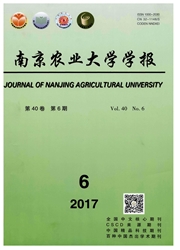

 中文摘要:
中文摘要:
利用免疫新西兰大白兔制备Cry1C毒素多克隆抗体,建立间接竞争时间分辨荧光免疫分析(CI-TRFIA)方法,用于稻米中Cry1C毒素的残留检测。通过4次免疫,采集Cry1C毒素多克隆抗体血清,并用饱和硫酸铵沉淀和Protein A柱纯化,测定抗体效价;以制备Eu-N1标记的羊抗兔IgG作为检测抗体,建立Cry1C毒素的CI-TRFIA检测方法,并进行抗原类似物的特异性分析和Cry1C毒素在稻米中的添加回收试验。结果表明:获得的多克隆抗体质量浓度为3.86 mg·mL^-1,效价为1∶48 000;建立的CI-TRFIA检测方法,其灵敏度(IC10)为0.074 ng·mL^-1,中抑制浓度(IC50)为60.16 ng·mL^-1,线性检测范围(IC20~IC80)为0.96~1 633.60 ng·mL^-1;对Cry1B、Cry1Ab和Cry1Ac均有一定的交叉反应;添加回收试验的批内、批间回收率为84.53%~107.12%,变异系数为6.05%~11.24%。结论:该检测方法稳定性和重复性较好,可以满足Cry1C毒素的检测要求。
 英文摘要:
英文摘要:
In this study,an approach of indirect competitive time-resolved fluorescence immunoassay( IC-TRFIA) was developed for the detection of Cry1 C toxin in rice. Anti-Cry1 C toxin polyclonal antibody was produced via New Zealand White rabbits immunization,then purified and concentrated by saturated ammonium sulphate and Protein A column. Thereafter,an indirect competitive TRFIA( CI-TRFIA) was developed for the determination of Cry1 C toxin and analogues based on polyclonal antibody. Finally,the method was verified by spiked rice sample detection. The results showed that the concentration and titer of purified antibody was confirmed to be 3. 86 mg·mL^-1,1∶48 000,respectively,and in the range of 0.96-1 633.60 ng·mL^-1,the IC50 and the IC10( detection limit) of this approach could reach to 60. 16 ng·mL^-1and 0. 074 ng·mL^-1,respectively,however,cross-reacting with toxin of Cry1 B,Cry1Ab and Cry1 Ac was also obtained. For the spiked rice sample detection,the results showed that the recoveries of Cry1 C toxin were ranged from 84. 53% to 107. 12%,with CV ranged from 6. 05% to 11. 24%. Conclusions: The developed approach of IC-TRFIA is repeatable and stable,and can be used for the determination of Cry1 C toxin in rice.
 同期刊论文项目
同期刊论文项目
 同项目期刊论文
同项目期刊论文
 期刊信息
期刊信息
